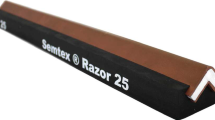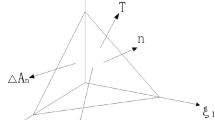Conclusions
It has been shown that the state of strain in the contact zone of dynamically interacting surfaces can be revealed by the recrystallization method. The interval of homologous temperatures for determining the state of strain of the joints and the intense plastic deformation zone R, a parameter related to the physical conditions of realization of bulk-atom interaction on the intracontact surface, has been found.
It has been shown, with reference to the example of explosive-welded copper and nickel blanks, that for equivalent welding conditions the values of the intense plastic deformation zone are equal and for different materials amount to 0.8–1.5% of the thickness of the flyer plate depending on the roughness of the impact surfaces.
Explosive welding and bond formation in powder compaction have both been shown to be primarily a consequence of deformation processes localized at the contacts, which introduce into the initial system a new structural level of plastic flow.
There is two-orders difference between the powers of the localized plastic strain energy released at the contacts and required for strong bond formation in explosive welding and powder compaction respectively.
Similar content being viewed by others
Literature Cited
A. A. Deribas, Physics of Explosive Hardening and Welding [in Russian], Nauka, Novosibirsk (1980).
V. F. Nesterenko, A. N. Lazaridi, S. A. Pershin, and co-workers, “Properties of compacts made from rapid-hardened steel granules of various fractions obtained by shock-wave pressing,” in: Proc. Intern. Seminar on the High-Energy Working of Rapid-Hardened Materials, 1988 [in Russian], Novosibirsk (1988).
R. P. Prummer, “Explosive compaction of powders — state of art,” in: High Energy Rate Fabrication, Proc. 9th Intern. Conf., 18–22 Aug. 1986 [in Russian], Novosibirsk (1986).
A. A. Deribas, V. V. Pai, and V. A. Simonov, “Collision characteristics of large plates and some supplementary constraints on the welding range,” in: Explosive Working of Metals, Marianské Lazni (1976).
A. Loyer, M. Telerman, D. Hay et al., “Explosive welding: the weldability window for dissimilar metals and alloys,” in: Explosive Working of Metals, Marianské Lazni (1976).
M. D. Mayer, “Impact welding using magnetically driven flyer plates,” 4th Intern. Symp. of the Center for High-Energy Forming, Denver, Col. (1973).
F. Mckee and B. Crossland, “Further experiments on the mechanism of explosive welding,” ibid.
S. W. Stivers and R. H. Wittman, “Computer selection of the optimum explosive loading and weld geometry,” ibid.
R. H. Wittman, “The influence of collision parameters on the strength and microstructure of explosion-welded aluminium alloys,” 2nd Intern. Symp. on the Use of Explosive Energy, Marianské Lazni (1973).
A. Oberg, N. Martensson, and J. A. Schweitz, “Fundamental aspects of formation and stability of explosive welds,” Metallurgical Trans.,16A (1985).
A. N. Kriventsov and V. S. Sedykh, “Role of plastic deformation of metals in the explosive-welded joint zone,” Fiz. Khim. Obrab. Mater., No. 1 (1969).
S. K. Godunov, A. A. Deribas, I. D. Zakharenko, and coworkers, “Investigation of the viscosity of metals in high-speed collisions,” Fiz. Goreniya Vzryva,7, No. 1, (1971).
M. P. Bondar' and V. M. Ogolikhin, “Plastic deformation in the joint zone in explosive platting,” Fiz. Goreniya Vzryva,21, No. 5 (1985).
M. P. Bondar' and V. M. Ogolikhin, “Plastic deformation and bonding in the explosive welding of copper plates,” Fiz. Goreniya Vzryva,24, No. 1 (1988).
I. D. Zakharenko, “Governing processes in explosive welding,” Fiz. Goreniya Vzryva,15, No. 3 (1979).
J. Yucel Birol, “Plastic zone characterization by recrystallization,” J. Mater. Sci Lett., No. 6 (1987).
G. E. Burke and D. Turnbull, Advances in Metal Physics [Russian translation], Moscow (1956).
A. M. Staver, “Metallurgical effects under shock compression of powder materials,” in: Shock Waves and High-Strain-Rate Phenomena in Metals. Concepts and Applications (eds. M. A. Meyers and L. E. Murr), Plenum Press, N. Y.-London (1981).
M. P. Bondar', V. F. Nesterenko, T. S. Teslenko, and coworkers, “Optimization of the heat treatment regimes of explosive compacts made from rapid-hardened granules of chrome steel,” Mater. 5th All-Union Conf. on Impulsive Working of Materials [in Russian], Novosibirsk (1990).
O. V. Roman, V. F. Nesterenko, and I. M. Pikus, “Effect of powder particle size on the explosive pressing process,” Fiz. Goreniya Vzryva, 15, No. 5, 102–107 (1979).
D. Raybould, “The cold welding of powders by dynamic compaction,” Intern. J. of Powder Metallurgy and Powder Technology,16, No. 1 (1980).
V. F. Nesterenko, “Heterogeneous heating of porous materials in shock-wave deformation and criterion of strong compact formation,” in: High-Energy Forming of Materials, Proc. 9th Intern. Conf., Novosibirsk, 18–22 Aug. 1986 [in Russian], Novosibirsk (1986), pp. 157–163.
R. B. Schwarz, P. Kasiraj, T. Vreeland, Jr., et al., “The effect of shock duration on the dynamic consolidation of powder,” in: Shock Waves in Condensed Matter, Proc. Amet. Phys. Soc. Topical Conf., July 1983, Santa Fe, Elsevier (1984).
T. J. Ahrens et al., “Shock compaction of molybdenum powder,” in: Shock Waves in Condensed Matter, Proc. Am. Phys. Soc. Topical Conf., July 1983, ibid.
V. F. Nesterenko, “Micromechanics of powders under intense impulsive loading,” Mater. 10th All-Union Conf. on “Numerical Methods of Solving Problems of the Theory of Elasticity and Plasticity” [in Russian], Novosibirsk (1988), pp. 212–220.
V. F. Nesterenko and A. N. Lazaridi, “Regimes of shock-wave compaction of granular materials,” Proc. 12th Intern. Conf. AIRAPT, Padeborn (1989).
V. F. Nesterenko, “Nonlinear effects in condensed heterogeneous media under impulsive loading,” Mater. All-Union Conf. on Highly Excited States [in Russian], Tomsk (1990).
M. L. Wilkins and C. F. Cline, “Simulation of explosive compaction experiment,” Proc. 2nd meeting on Explosive Working of Materials, Novosibirsk, 8–10 Sept. 1981 [in Russian], Inst. Hydrodyn., Novosibirsk (1981), pp. 166–173.
M. L. Wilkins, “Dynamic powder compaction,” Intern. Conf. on High Energy Rate Fabrication, San Antonio (1984).
V. F. Nesterenko, “Nonlinear effects in the impulsive loading of heterogeneous condensed media,” Doctoral Thesis, Novosibirsk (1988).
M. M. Carroll, K. T. Kim, and V. F. Nesterenko, “The effect of temperature on viscoplastic pore collapse,” J. Appl. Phys., 59, No. 6 (1986).
A. S. Kusubov, V. F. Nesterenko, M. L. Wilkins, and coworkers, “Dynamic deformation of powder materials as a function of particle size,” Proc. Intern. Seminar on High Energy Working of Rapidly Solidified and High-Temperature Superconducting Materials [in Russian], Novosibirsk (1989).
V. F. Nesterenko, “Possibilities of shock-wave methods of obtaining and compacting rapidly hardened materials,” Fiz. Goreniya Vzryva,21, No. 6, 85–98 (1985).
V. F. Nesterenko, “On the thermodynamics of shock compression of porous materials,” in: Explosive Working of Metals, Trans. 2nd Intern. Symp. on the Explosive Working of Materials, Vol. 2, Marianské Lazni (1976).
D. Raybould, “Some theoretical aspects and mechanical properties of dynamic compacts,” Mater. Intern. Conf. on High Energy Rate Fabrication, San Antonio (1984).
R. L. Williamson and R. Berry, “Microlevel numerical modeling of the shock wave induced consolidation of metal powders,” in: Shock Waves in Condensed Matter, Plenum Press, New York-London (1986).
M. P. Bondar, V. F. Nesterenko, and A. N. Lazaridi, “A new method of production of strong compacts from rapidly solidified granules by explosively thermal treatment,” Trans. Intern. Conf. on “New Methods in the Physics and Mechanics of Deformable Solids”, Pt. 2 [in Russian], Tomsk Univ. Press, Tomsk (1990).
Additional information
Novosibirsk. Translated from Fizika Goreniya i Vzryva, Vol. 27, No. 3, pp. 103–117, May–June, 1991.
Rights and permissions
About this article
Cite this article
Bondar', M.P., Nesterenko, V.F. Contact deformation and bonding criteria under impulsive loading. Combust Explos Shock Waves 27, 364–376 (1991). https://doi.org/10.1007/BF00789672
Received:
Issue Date:
DOI: https://doi.org/10.1007/BF00789672




